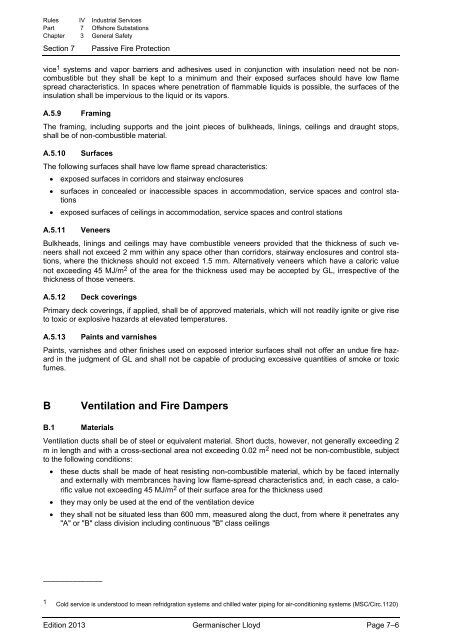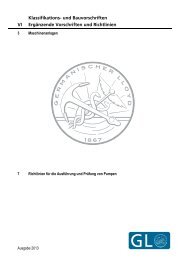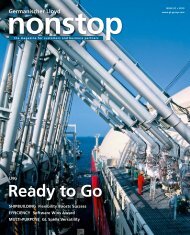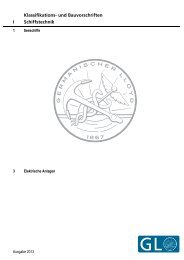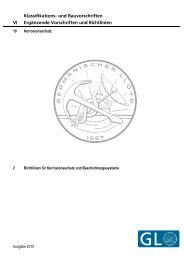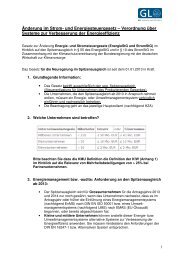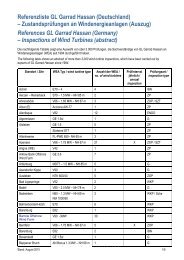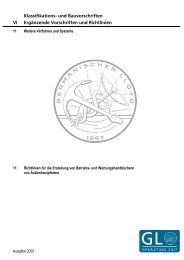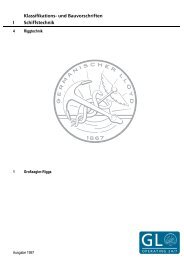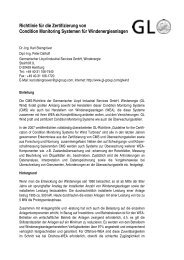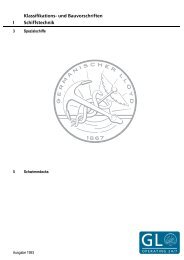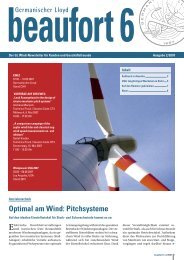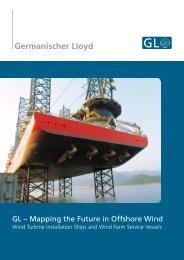(IV-7-3) General Safety
(IV-7-3) General Safety
(IV-7-3) General Safety
Create successful ePaper yourself
Turn your PDF publications into a flip-book with our unique Google optimized e-Paper software.
Rules <strong>IV</strong> Industrial Services<br />
Part 7 Offshore Substations<br />
Chapter 3 <strong>General</strong> <strong>Safety</strong><br />
Section 7<br />
Passive Fire Protection<br />
vice 1 systems and vapor barriers and adhesives used in conjunction with insulation need not be noncombustible<br />
but they shall be kept to a minimum and their exposed surfaces should have low flame<br />
spread characteristics. In spaces where penetration of flammable liquids is possible, the surfaces of the<br />
insulation shall be impervious to the liquid or its vapors.<br />
A.5.9 Framing<br />
The framing, including supports and the joint pieces of bulkheads, linings, ceilings and draught stops,<br />
shall be of non-combustible material.<br />
A.5.10 Surfaces<br />
The following surfaces shall have low flame spread characteristics:<br />
• exposed surfaces in corridors and stairway enclosures<br />
• surfaces in concealed or inaccessible spaces in accommodation, service spaces and control stations<br />
• exposed surfaces of ceilings in accommodation, service spaces and control stations<br />
A.5.11 Veneers<br />
Bulkheads, linings and ceilings may have combustible veneers provided that the thickness of such veneers<br />
shall not exceed 2 mm within any space other than corridors, stairway enclosures and control stations,<br />
where the thickness should not exceed 1.5 mm. Alternatively veneers which have a caloric value<br />
not exceeding 45 MJ/m 2 of the area for the thickness used may be accepted by GL, irrespective of the<br />
thickness of those veneers.<br />
A.5.12 Deck coverings<br />
Primary deck coverings, if applied, shall be of approved materials, which will not readily ignite or give rise<br />
to toxic or explosive hazards at elevated temperatures.<br />
A.5.13 Paints and varnishes<br />
Paints, varnishes and other finishes used on exposed interior surfaces shall not offer an undue fire hazard<br />
in the judgment of GL and shall not be capable of producing excessive quantities of smoke or toxic<br />
fumes.<br />
B<br />
Ventilation and Fire Dampers<br />
B.1 Materials<br />
Ventilation ducts shall be of steel or equivalent material. Short ducts, however, not generally exceeding 2<br />
m in length and with a cross-sectional area not exceeding 0.02 m 2 need not be non-combustible, subject<br />
to the following conditions:<br />
• these ducts shall be made of heat resisting non-combustible material, which by be faced internally<br />
and externally with membrances having low flame-spread characteristics and, in each case, a calorific<br />
value not exceeding 45 MJ/m 2 of their surface area for the thickness used<br />
• they may only be used at the end of the ventilation device<br />
• they shall not be situated less than 600 mm, measured along the duct, from where it penetrates any<br />
"A" or "B" class division including continuous "B" class ceilings<br />
––––––––––––––<br />
1 Cold service is understood to mean refridgration systems and chilled water piping for air-conditioning systems (MSC/Circ.1120)<br />
Edition 2013 Germanischer Lloyd Page 7–6


